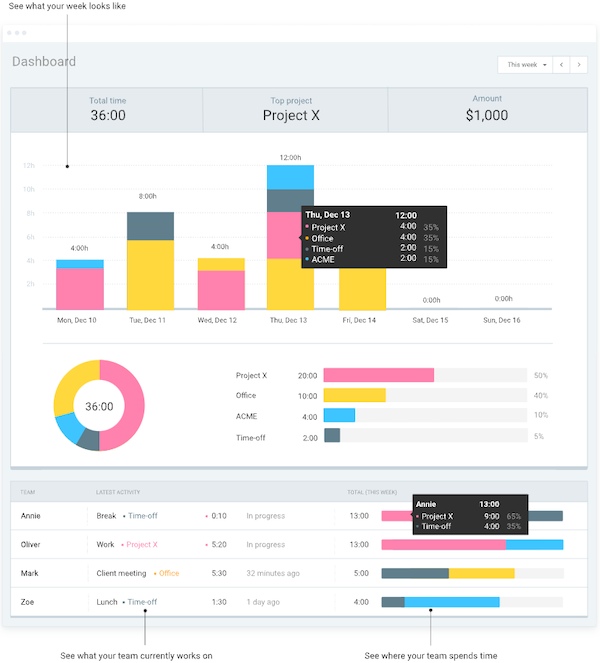We’ve all been there — staring at a pile of tasks, feeling overwhelmed, with no idea where even to start.
It’s easy to feel like you’re drowning when you constantly deal with project delays and an overflowing inbox.
The good news?
You’re not alone, and there’s a way out of this mess.
Prioritizing tasks can turn your overwhelming day into one that feels manageable.
It’s not about doing everything at once — it’s about knowing what to tackle first and how to prioritize tasks efficiently. And we’re here to help you figure that out!

Set task priority to prevent multitasking and efficiency loss
Multitasking leads to a productivity drop by as much as 40%, according to research from the American Psychological Association.
And the cause?
More often than not, it’s poor prioritization. But when you know how to prioritize tasks, you can declutter your brain and become more efficient.
Prioritize tasks with Clockify
A Stanford psychologist reveals that multitasking can result in reduced memory and poor work performance. That’s because our brains are designed to fully focus on one thing at a time.
Even working on just 2 cognitively demanding tasks at the same time can cause your brain to struggle. That said, both tasks would need more attention to be done well.
Interestingly, people who take pride in their multitasking ability often tend to be less efficient than those who focus on a single task.
This is further confirmed by a 2020 study on constant interruptions at work. Essentially, humans are meant to be monotaskers — doing one task at a time. Not only is multitasking lowering the brain’s efficiency but it can also lead to stress, feelings of sadness, and negative moods in general.
When you fail to employ your prioritization skills, you can easily get stuck in doing time-consuming tasks that provide no immediate value. But by setting real task priority, you can:
- Reduce decision fatigue,
- Work more intentionally, and
- Feel less stressed.
This boosts your productivity and overall sense of accomplishment.
💡 CLOCKIFY PRO TIP
It’s not easy to give it your all and maintain productivity during your 8-hour workdays. But not all is lost, as science has the answer to becoming your most productive self:
Decide which tasks are most important — with the Eisenhower matrix
It’s easy to think everything is urgent and important when your task list is long. But here’s the secret — not everything is!
Instead, use the Eisenhower matrix to improve your prioritization skills. Think of it as a simple method that helps you decide the priority levels for tasks.
Urgent tasks are those that truly need immediate attention (like an email from your boss with a tight deadline). Important tasks, on the other hand, contribute to your long-term goals (such as project planning, for example).
Once you successfully separate these 2 categories, you’ll also see that some tasks are neither urgent nor important — and those are the ones you can potentially remove.
Start by labeling tasks:
- Urgent and important — do these first,
- Important but not urgent — schedule time for these,
- Urgent but not important — delegate if possible, and
- Neither urgent nor important — eliminate them.
Implementing this prioritization method from the start lets you deal with time-sensitive and important work first, while staying focused and reducing stress at the same time. And you can finally escape the trap of constantly reacting to emergencies.
Travel and lifestyle writer and editor Lissa Poirot combines the Eisenhower matrix with time blocking. Her secret is not just to categorize tasks by urgency and importance but also to align energy levels with task importance:

“By matching high-energy periods with high-priority tasks, I noticed a significant boost in both productivity and job satisfaction. I wasn’t just checking off boxes — I was doing my best work when I felt most capable. It’s something people don’t always think about: matching the right time of day with the right kind of task can have a bigger impact on efficiency than just listing tasks by urgency alone.”
💡 CLOCKIFY PRO TIP
The way you do your work and how efficient you are may completely change once you find the perfect time management technique for you:
Handle multiple important tasks by reassessing your to-do list
What do you do when everything feels important? To escape the juggling loop, take notice of what they do in emergency rooms and — triage your tasks.
Start by checking deadlines — what needs to happen right now and what can wait? Then, look at the long-term impact. Which tasks are crucial for your work goals and which ones just feel urgent?
For your prioritization exercises, practice some balance between immediate value and value that will show over time. Remember — sometimes, it’s perfectly fine (and necessary!) to let go of the “less urgent” important tasks.
Executive and personal empowerment life coach Smita Das Jain reveals that by focusing on fewer tasks that matter most, she achieves more in less time and also avoids the overwhelming feeling of juggling too many tasks at once:

“I follow my own ‘rule of 3,’ where I identify the top 3 objectives for the coming week at the end of the current one, and then prioritize 3 key tasks each day that directly align with these objectives. This helps me maintain clarity and focus on what truly drives progress, ensuring my efforts are aligned with larger goals.”
Use practical prioritization methods to stay on track
Staying on track may feel impossible when distractions are all around you. However, you can still regain control of your day by trying a few simple strategies.
First, try time blocking. This particular method lets you choose time intervals for one specific task. So, for example, you may pick an interval between 10 a.m. and 11 a.m. when you will solely focus on your social media calendar. During that time, you’re not allowed to do anything else, such as managing emails.
Technology entrepreneur and investor Jeremy Yamaguchi is a huge fan of time blocking. He explains that knowing exactly what to work on and when improves his efficiency and productivity immensely:

“You go through your day knowing exactly what you are to be working on and when, which allows you to spend your time more efficiently and prevent multitasking. Time blocking is all about optimizing your time in a way that gets everything done efficiently, productively, and purposefully.”
Another helpful method is making a priority list. The simplest way to go about this method is to create a list of your most important tasks as soon as your workday starts.
For an added motivation boost, cross tasks off as you go. Ideally, strive to complete your highest-priority task first and then go from there through your list.
Using the Pomodoro technique can also be a game-changer. This method is rather easy to implement in your routine, too. The whole point is to have scheduled intervals for work time and breaks.
The common pattern for the Pomodoro technique involves 25 minutes of focused work with 5-minute breaks. Of course, you can customize intervals that suit your needs and preferences more.
Conveniently, you can use these prioritization methods as part of Clockify’s features.
💡 CLOCKIFY PRO TIP
You can’t seem to find your ideal productivity method? Well, maybe it’s time to stop wasting time on popular productivity hacks:
Clockify: A tool for effective task prioritization
When you have multiple tasks on your to-do list, staying organized can be tricky — but this is where Clockify comes in.
Clockify isn’t just a time tracker — it’s a powerful tool for task prioritization that helps you focus on tasks that are truly important.
With Clockify, you can break your projects into smaller and more manageable tasks with defined deadlines.
Need to figure out what to do first?
Thanks to Clockify’s dashboard, you can easily visualize all your tasks and sort them by deadlines or importance. That way, you quickly decide what tasks require your immediate attention and which ones can wait.

If you find yourself constantly pulled in different directions, Clockify can get you out of chaos and bring clarity to your day.



